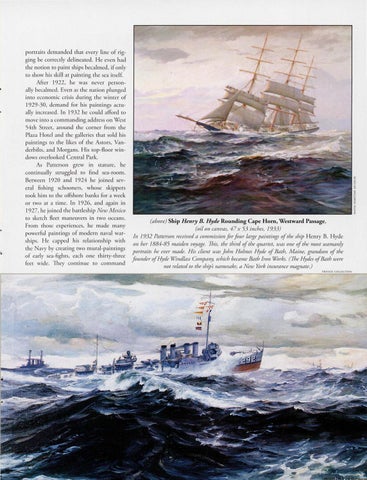ponraits demanded that every line of rigging be correctly delineated . H e even had the notion to paint ships becalmed, if only to show his skill at painting the sea itself. After 1922, he was never perso nal ly becalmed. Even as the natio n plunged into econo mic crisis during the winter of 1929-30, demand for his paintings actually increased. In 1932 he could afford to m ove in to a commanding address o n Wes t 54th Street, aro und the co rner fro m the Plaza H otel and the galleries that sold his paintings to the likes of the As tors, Va nderbilts, and Morgans. His top-Aoor windows overlooked Central Park. As Patrerson grew in stature, he co ntinually struggled to find sea-roo m. Between 1920 and 1924 he jo ined several fishing sch oo ners, whose skippers roo k him to the offshore banks fo r a wee k o r rwo at a tim e. In 1926, and again in 1927, he joined the battleship New Mexico to sketch Aeet maneuvers in two ocea ns. (above) Ship Henry B. Hyde Rounding Cape Horn, Westward Passage, From those ex peri ences, he made many (oil on canvas, 47 x 53 inches, 1933) powe rful paintings of modern naval wa rIn 1932 Patterson received a commission for four large paintings of the ship H enry B. H yde ships. H e capped his relatio nship with on her 1884-85 maiden voyage. This, the third of the quartet, was one of the most seaman61 the Navy by creating two mural-paintin gs portraits he ever made. H is client was j ohn H olmes Hyde of Bath, Maine, grandson of the of earl y sea-fi ghts, each o ne thir ty- th ree founder ofHyde Windlass Company, which became Bath Iron Works. (The Hydes ofBath were feet wide. They continue to command not related to the ship's namesake, a New York insurance magnate.)
Issuu converts static files into: digital portfolios, online yearbooks, online catalogs, digital photo albums and more. Sign up and create your flipbook.
